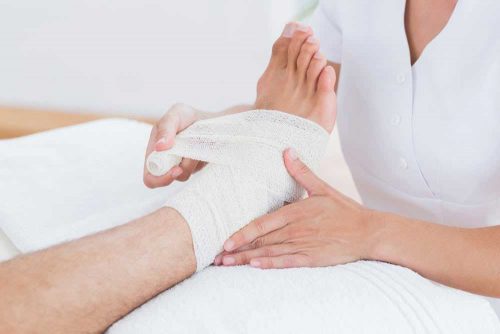Wound Care
 Dr. Aquino, vascular surgeon, specializes in wound care. She is a member of Seton Medical Center’s wound care center. This is a multidisciplinary center that exists in order to heal difficult wounds. She treats venous and arterial wounds as well as other wounds like decubitus ulcers, diabetic foot wounds, surgical site wounds, and any other chronic wounds
Dr. Aquino, vascular surgeon, specializes in wound care. She is a member of Seton Medical Center’s wound care center. This is a multidisciplinary center that exists in order to heal difficult wounds. She treats venous and arterial wounds as well as other wounds like decubitus ulcers, diabetic foot wounds, surgical site wounds, and any other chronic wounds
Wound treatment for venous wounds
Venous wounds are the result of poor blood return to the heart. In these patients, the venous system is working poorly and the valves in the veins are not able to propel the blood upwards into the heart. This results in “venous hypertension”. The area of the leg most commonly affected the most is on the inner part of the ankle. This is where venous ulcers are most often appear.
Unlike arterial ulcers, venous ulcers are not always painful. They are usually associated with skin darkening (brawny induration), skin thickening (lipodermatoscerlosis), and varicose veins.
Compression
The mainstay of wound therapy for venous ulcers is compression therapy. Occasionally compression stockings are successful when the patient consistently wears them over dressings. But most commonly, we apply a four layer wrap on the lower leg and change it at least twice weekly. This treats the swelling (edema) in the leg, and allows the healing process to progress. The patient wears the wraps at all times so the swelling does not re-accumulate. The dressings are changed regularly so the wound can be monitored and re-dressed.
Debridement
One critical element of healing all wounds, including venous wounds, is debridement. This refers to the removal of all dead or infected tissue from the wound on a regular basis. The vein surgeon uses a scalpel or a curette to scrape the dead tissue off the wound. The regular removal of dead and infected tissue allows the wound to heal itself, and often “activates” the wound so that the cells involved in healing function optimally.
Antimicrobials
Often, venous wounds do not heal because of bacterial infection. We treat these wounds first by obtaining a wound culture and administering antibiotics if necessary. Dressings on the wounds often employ antimicrobial agents which decrease surface bacteria and promote healing. Examples of such agents include silver impregnated dressings, honey, and iodine impregnated dressings.
Moisture
Wound treatment is optimal in a moist environment. A little moisture is critical to allow wound healing cells to function well. Examples of moist dressings include hydrocolloids, alginates, and hydrogels.
Negative Pressure Wound Therapy (“Wound Vacs”)
Wound vac devices are occasionally placed on wounds, especially large wounds, in order to accelerate healing. These devices work by exerting a negative pressure, or vacuum on the wound, which reduces edema, increases the rate of granulation tissue formation, and increases the development of new skin (epithelialization.)
Surgery
Surgery including non-invasive endovenous therapies (radiofrequency ablation or laser ablation) is another option to treat venous wounds. There is some debate about the timing of these procedures in the setting of wound care. It has been the traditional approach to heal the vein wounds first, prior to treating superficial vein with ablation. However, occasionally, if there is difficulty with wound healing, or a failure of progression to healing, surgical therapies are employed, often with excellent results.
Wound treatment for arterial wounds
Arterial wounds that occur when there is not enough blood flow in the arteries to deliver the amount of blood needed to heal the wound. When patients have peripheral arterial disease, there are blockages in the arteries of the leg. Sometimes this can result in symptoms such as pain with walking because the arteries cannot deliver enough blood to working muscles in the leg. This condition is claudication.
However, sometimes patients with PAD develop wounds in their leg, often with mild trauma (like a cut during a pedicure, or during a visit to a podiatrist, for example). Once there is a wound in the leg, the arteries have to deliver more blood to the foot in order to heal the wound. However, since there are blockages in the arteries, the body suddenly cannot deliver enough blood to the leg, and the wound does not heal. This often results in a leg ulcer which is very painful, and a wound which looks old, and pale pink, or even black.
Unlike healing venous wounds, the mainstay of therapy for arterial wounds is revascularization. This is a term which simply means restoring arterial flow to the leg. In order to do this, surgeons have to determine the location of the blockages, and treat them with either endovascular treatment such as stents or balloon angioplasty,
Once wounds have adequate arterial circulation for healing, we continue to employ the treatments above in order to assure healing. This includes therapies such as debridement, hydrocolloids, alginates, skin substitutes, and negative pressure wound therapy, if needed.
Wound therapy centers
Dr. Aquino is an active member of the St. Mary’s and Seton Wound Care Centers, and works with plastic surgeons and podiatrists as well as the trained wound care specialists in order to heal even the most serious wounds from venous ulcers.
Regular visits to the wound center allow Dr. Aquino to evaluate the wounds regularly and to change the treatment plan if needed. Patients with venous or arterial wounds need special care and attention, and we are there for them every step of the way.
